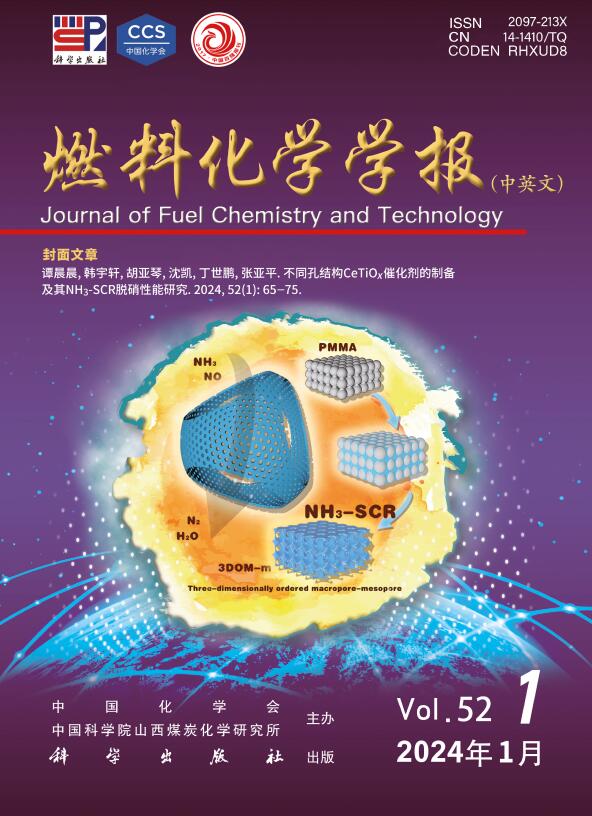Hydrothermal N-doping assisted synthesis of poplar sawdust-derived porous carbons for carbon capture
Q3 Energy
引用次数: 0
Abstract
To optimize the CO2 adsorption performance of carbon materials, this study proposed a preparation method for biomass-based porous carbon through hydrothermal carbonization coupled with nitrogen source optimization and K2CO3 activation. The effects of different nitrogen sources (urea, piperazine, melamine, and polyaniline) and activation temperatures on the physicochemical features and CO2 adsorption characteristics of the porous carbons were systematically investigated. The results indicated that different nitrogen sources showed varying impacts on the CO2 uptake of porous carbons, and not all nitrogen sources enhanced the adsorption performance. The urea and piperazine doped porous carbons exhibited relatively low nitrogen contents and specific surface areas. Whereas the melamine doped carbons showed higher nitrogen contents and specific surface areas, but lacked narrow micropores, limiting their CO2 adsorption performance. In contrast, PAC-700, prepared using polyaniline as nitrogen source, featured a well-developed pore structure, abundant narrow micropores and pyrrolic-N groups, endowing it with enhanced CO2 adsorption capability. At 0 °C/1 bar and 25 °C/1 bar, the CO2 uptake of PAC-700 reached 6.85 and 4.64 mmol/g, respectively. Additionally, PAC-700 maintained a CO2 uptake retention ratio of 99% after 5 adsorption-desorption cycles and exhibited good CO2/N2 selectivity of 22.4−51.6. These findings highlighted the advantageous CO2 adsorption performance of PAC-700, indicating its substantial application potential in the domain of carbon capture.
水热n掺杂辅助合成用于碳捕获的杨木木屑衍生多孔碳
为了优化碳材料对CO2的吸附性能,本研究提出了一种生物质基多孔碳的制备方法:水热炭化、氮源优化和K2CO3活化。系统考察了不同氮源(尿素、哌嗪、三聚氰胺和聚苯胺)和活化温度对多孔炭的理化特性和CO2吸附特性的影响。结果表明,不同的氮源对多孔碳吸附CO2的影响不同,并不是所有的氮源都能提高多孔碳的吸附性能。尿素和哌嗪掺杂的多孔碳具有相对较低的氮含量和比表面积。而三聚氰胺掺杂碳具有较高的氮含量和比表面积,但缺乏狭窄的微孔,限制了其CO2吸附性能。而以聚苯胺为氮源制备的PAC-700孔结构发达,具有丰富的窄微孔和吡咯- n基团,具有较强的CO2吸附能力。在0°C/1 bar和25°C/1 bar条件下,PAC-700的CO2吸收量分别达到6.85和4.64 mmol/g。此外,PAC-700在5次吸附-解吸循环后仍保持99%的CO2吸收保留率,CO2/N2选择性为22.4 ~ 51.6。这些研究结果表明PAC-700具有良好的CO2吸附性能,在碳捕集领域具有巨大的应用潜力。
本文章由计算机程序翻译,如有差异,请以英文原文为准。
求助全文
约1分钟内获得全文
求助全文
来源期刊

燃料化学学报
Chemical Engineering-Chemical Engineering (all)
CiteScore
2.80
自引率
0.00%
发文量
5825
期刊介绍:
Journal of Fuel Chemistry and Technology (Ranliao Huaxue Xuebao) is a Chinese Academy of Sciences(CAS) journal started in 1956, sponsored by the Chinese Chemical Society and the Institute of Coal Chemistry, Chinese Academy of Sciences(CAS). The journal is published bimonthly by Science Press in China and widely distributed in about 20 countries. Journal of Fuel Chemistry and Technology publishes reports of both basic and applied research in the chemistry and chemical engineering of many energy sources, including that involved in the nature, processing and utilization of coal, petroleum, oil shale, natural gas, biomass and synfuels, as well as related subjects of increasing interest such as C1 chemistry, pollutions control and new catalytic materials. Types of publications include original research articles, short communications, research notes and reviews. Both domestic and international contributors are welcome. Manuscripts written in Chinese or English will be accepted. Additional English titles, abstracts and key words should be included in Chinese manuscripts. All manuscripts are subject to critical review by the editorial committee, which is composed of about 10 foreign and 50 Chinese experts in fuel science. Journal of Fuel Chemistry and Technology has been a source of primary research work in fuel chemistry as a Chinese core scientific periodical.
 求助内容:
求助内容: 应助结果提醒方式:
应助结果提醒方式:


